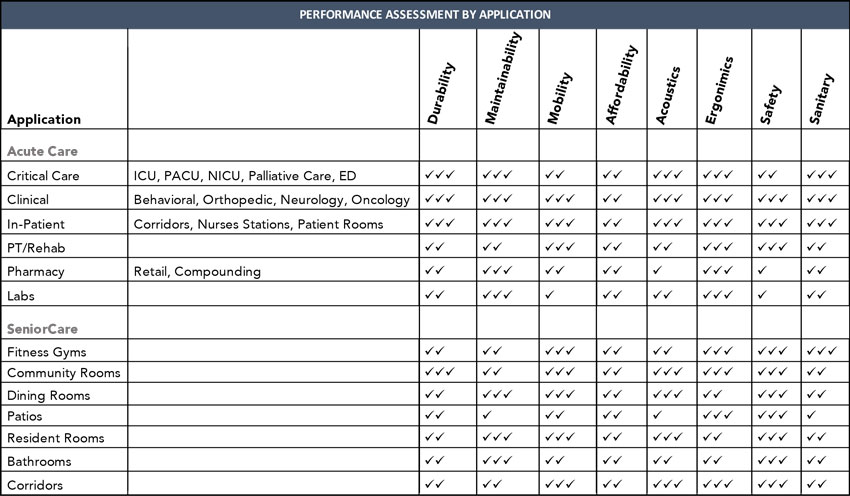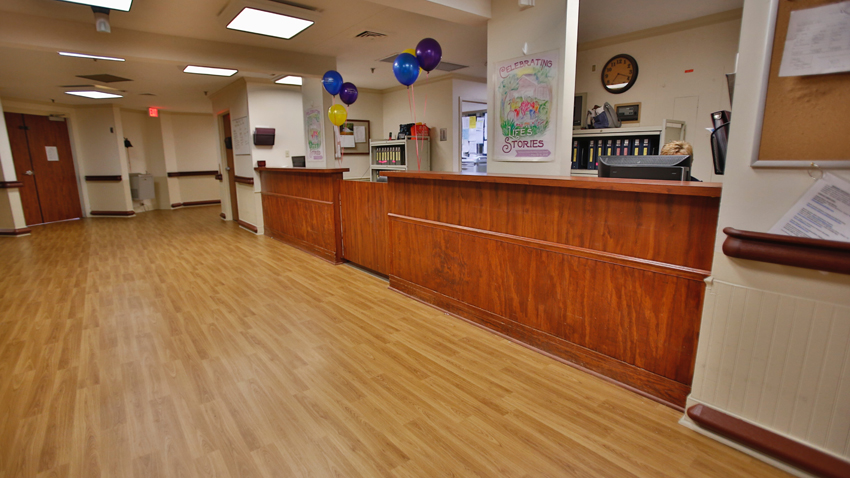Health-Care Flooring for the New Normal
Specifying the Right Flooring Product for the Application
The key to savvy specification of flooring for health-care settings is to identify the needs of the client and how the specification will impact staff, patients, and residents. With the basic assumption that the flooring must meet performance standards for durability, maintainability, and both static and rolling load weights, other priorities to consider include:

Key: √ = important, √ √ = very important, √ √ √ = critically important
Conclusion
As we have seen, there are many challenges in a health-care setting, and recent events have only heightened our awareness of these challenges. We have also seen that flooring can be part of the solution to these problems.
The bar has been raised on what flooring can do, and higher expectations must be met. New technologies in flooring can directly affect the well-being of staff, patients, and the bottom line. As a result, engineered, resilient performance surfaces featuring a VCR backing that are durable, easy to maintain, contribute to mobility, reduce noise, are hygienic, and create a safer environment must be specified in health-care applications. With this data-based knowledge, architects, designers, and specifiers now have the information they need to bring benefits to everyone who comes into contact with a health-care setting.

With data-based knowledge, architects, designers, and specifiers can choose flooring that reduces noise, creates a more hygienic environment, contributes to mobility, increases safety, and is durable and easy to maintain.
End Notes
1“Through the Eyes of the Workforce: Creating Joy, Meaning, and Safer Health Care.” Lucian Leape Institute. National Patient Safety Foundation. 2013. Web. 12 September 2020.
2“Adult Obesity Facts.” Centers for Disease Control and Prevention. Web. 12 September 2020.
3Gaines, Kathleen. “This is How COVID-19 is Changing the Future of Nursing for Students and Tenured Nurses.” Nurse.org. 26 June 2020. Web. 12 September 2020.
4Jividen, Sarah. “7 Ways COVID-19 Will Change the Future of The Nursing for The Better.” Aspen University. 21 July 2020. Web. 12 September 2020.
5Fuller, Thomas and Bain, Evelyn. “Moving violations: negative impacts of standing and walking in nurses’ health.” Massachusetts Nurse Newsletter. Massachusetts Nurses Association. 15 October 2008. Web. 12 September 2020.
6“Caring for Our Caregivers: Facts About Hospital Safety.” Occupational Safety and Health Administration. September 2013. Web. 12 September 2020.
7McCarthy, D.O.; Ouimet, M.E.; and Daun, J.M. “Shades of Florence Nightingale: Potential Impact of Noise Stress on Wound Healing.” Holistic Nursing Practice. 1991. Web. 12 September 2020.
8Kenney, L. “HCAHPS Scores, the Patient Experience, and the Affordable Care Act from the Facility Perspective.” American Society for Health Care Engineering. 22 April 2016. Web. 12 September 2020.
9Berglund, Birgitta; Lindvall, Thomas; and Schwela, Dietrich. 1999. “Guidelines for Community Noise.” Stockholm University and Karolinska Institute for the World Health Organization. 1995. Web. 12 September 2020.
10Busch-Vishniac, I.; West, J.; Barnhill, C.; Hunter, T.; Orellana, D.; and Chivukula, R. “Noise levels in Johns Hopkins Hospital.” Journal of the Acoustical Society of America. December 2005. Web. 12 September 2020.
11Hagerman, I.; Rasmanis, G.; Blomkvist, V.; Ulrich, R.; Eriksen, C. A.; and Theorell, T. “Influence of intensive coronary care acoustics on the quality of care and physiological state of patients.” International Journal of Cardiology. 15 February 2005. Web. 12 September 2020.
12Mazer, S. E. “Reduce errors by creating a quieter hospital environment.” Patient Safety & Quality Healthcare. March/April 2005. Web. 12 September 2020.
13“Summary of the HIPAA Privacy Rule.” Office for Civil Rights. U.S. Dept. of Health and Human Services. 2003. Web. 12 September 2020.
14Paul, Adam L.; Arena, David A.; King, Eoin A.; and Celmer, Robert D. “Contribution of Floor Treatment Characteristics to Noise Levels in Health Care Facilities.” The Journal of the Acoustical Society of America 2014. Web. 12 September 2020.










